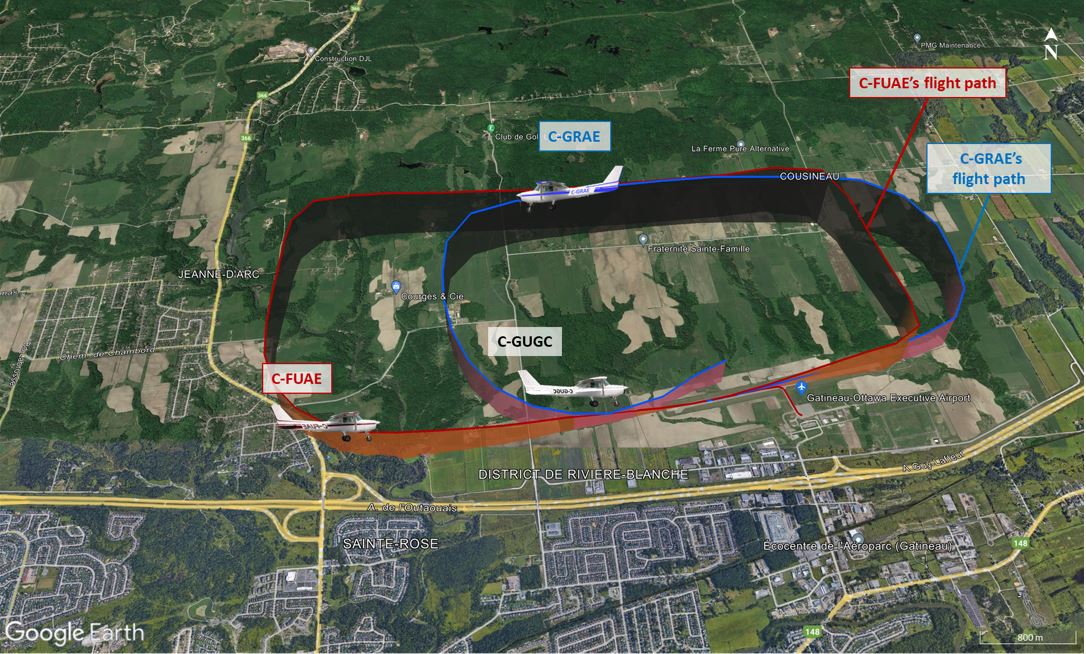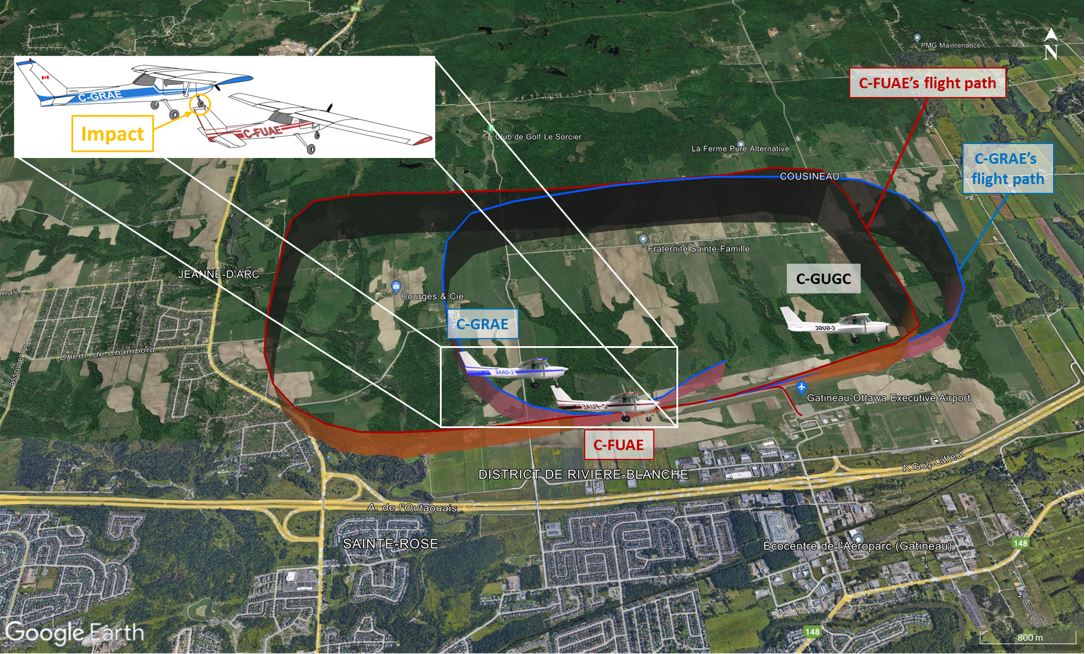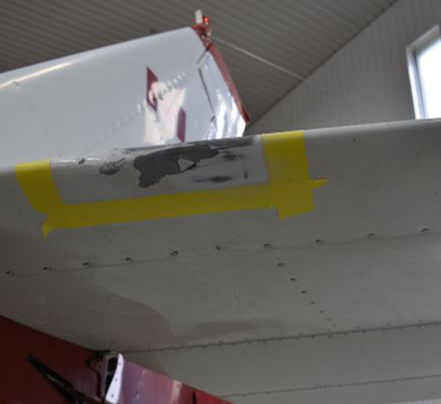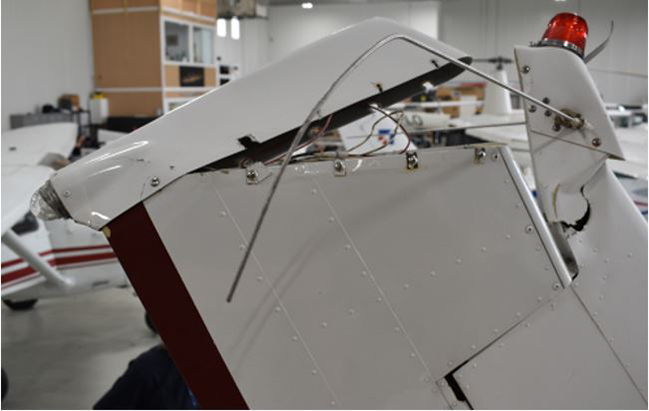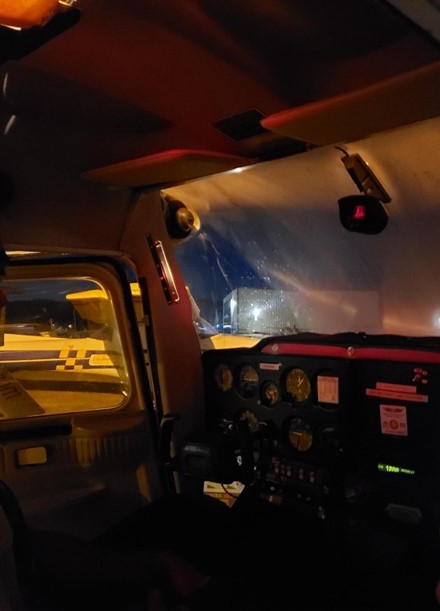Mid-air collision
Richcopter Inc. (dba Select Aviation College)
Cessna 150M, C-FUAE
and
Cessna 150M, C-GRAE
Ottawa/Gatineau Airport, Quebec
The Transportation Safety Board of Canada (TSB) investigated this occurrence for the purpose of advancing transportation safety. It is not the function of the Board to assign fault or determine civil or criminal liability. This report is not created for use in the context of legal, disciplinary or other proceedings. See Ownership and use of content. Masculine pronouns and position titles may be used to signify all genders to comply with the Canadian Transportation Accident Investigation and Safety Board Act (S.C. 1989, c. 3).
History of the flight
On the evening of 20 June 2023, 3 pilots from the Richcopter Inc. flight training unit (doing business as Select Aviation College) were preparing to conduct night circuits and touch-and-go manoeuvres on Runway 09 under visual flight rules (VFR) from the Ottawa/Gatineau Airport (CYND), Quebec, to meet night rating requirements. The 3 pilots were going to fly 3 Cessna 150 aircraft operated by the flight training unit. Before the training flights departed, the supervising instructor authorized the flights, conducted pre-flight briefings, and then supervised the flights in accordance with existing regulations. At the time of the occurrence, the flight training unit had not set a limit on the maximum number of its aircraft that could conduct circuits at the same time, but this is not required by regulation.
The 1st aircraft (registration C-GUGC) took off at 2128,Footnote 1 followed by the 2nd aircraft (registration C-FUAE) at 2130 and the 3rd aircraft (registration C-GRAE) at 2132. The 3 pilots successively made radio calls to state their intention to conduct touch-and-go manoeuvres on Runway 09. The calls were made when they were
- on initial climb;
- on the downwind leg;
- on the base leg; and
- on the final leg for Runway 09.
After C-GRAE completed its 1st touch-and-go, the 3 aircraft continued to make the calls indicated above. When the pilot of C-GUGC made his radio call on the final leg, C-GRAE was at the beginning of the downwind leg. When the pilot of C-FUAE made his radio call on the final leg for Runway 09 shortly afterward, C-GRAE was still on the downwind leg, approximately abeam the runway threshold. The pilot of C-GRAE noticed an aircraft on final approach, which he believed to be C-FUAE (number 2 on final). However, it was actually C-GUGC (number 1 on final), ahead of C-FUAE. Because the pilot of C-GRAE did not see C-FUAE, he believed he was number 2 on approach for the runway, began a turn onto the base leg, and made his radio call to report that he was turning onto the base leg (Figure 1).Footnote 2
A few seconds later, C-GRAE was directly above C-FUAE. At approximately 2145, when it was between 100 and 200 feet above ground level (AGL), C-GRAE struck the top of C-FUAE’s rudder and its vertical stabilizer (Figure 2).
At 2145:06, following the impact that was felt by the 2 pilots, the pilot of C-FUAE announced that he was going to land and stop, without stating a reason. The pilot of C-GRAE conducted a go-around, reported on initial climb, and said he was also going to conduct a full-stop landing. He then reported on the downwind leg and base leg, stating once again that he was going to conduct a full-stop landing. Just after the pilot of C-GRAE’s call on final, the pilot of C-FUAE, who was on the ground and had discovered that his aircraft was damaged, warned the pilots of the 2 aircraft still in flight to be careful on final approach because something had struck his aircraft, but he did not know if it had been a bird or something else. The pilot of C-GRAE did not acknowledge this communication and conducted 9 other touch-and-go manoeuvres, continuing to call in as usual. The pilot of C-GUGC landed and came to a full stop at 2249, followed by C-GRAE at approximately 2309.
Pilot information
Records indicate that the pilots of the 2 aircraft that collided held the appropriate licences and ratings for the flights in accordance with existing regulations. Both held a private pilot licence and a valid Category 1 medical certificate. The pilot of C-FUAE was doing the flight training for the integrated airline transport pilot licence (ATPL) program. He had accumulated approximately 71 total flight hours, including 21 hours of solo flight. The pilot of C-GRAE was completing a modular flight training program to obtain a commercial pilot licence. He had accumulated approximately 93 total flight hours, including about 21 hours of solo flight.
Weather information
According to the most recent aerodrome routine meteorological report for the day, issued at 2100 for CYND, weather conditions were as follows:
- Winds from 080° true at 4 knots
- Visibility of 10 statute miles
- Scattered clouds at 6900 feet AGL
- Temperature 21 °C, dew point 16 °C
- Altimeter setting 30.21 inches of mercury
These conditions matched those indicated in the aerodrome forecastFootnote 3 for CYND, issued on 20 June 2023 at 1341, and valid from 1400 to 2200. The next aerodrome forecast was to be issued at 0900 the next morning.
Weather conditions at CYND were suitable for a night VFR flight and are not considered to be a contributing factor in this occurrence.
Aircraft information
According to records, the 2 aircraft that collided (2 Cessna 150M aircraft) had been maintained in accordance with a maintenance schedule approved by Transport Canada. There were no recorded defects outstanding at the time of the occurrence. Furthermore, there was no indication that an aircraft system or component malfunction played a role in this occurrence .
Damage information
The damage sustained by the 2 aircraft is consistent with the angle of collision, direction of flight, and converging tracks of both aircraft (Figure 2).
During the collision sequence, C-GRAE’s nosewheel and then horizontal stabilizer struck the top of C-FUAE’s rudder and its vertical stabilizer, causing minor damage to both aircraft. C-GRAE’s horizontal stabilizer sustained only a slight deformation of the left leading edge and a superficial scratch to the lower skin (Figure 3). The upper part of C-FUAE’s rudder partially separated, and the upper part of the vertical stabilizer was bent forward and to the left (Figure 4).
Airspace and compulsory reporting
The collision occurred in the CYND control zone (Class E controlled airspace). There is no control tower at CYND, but there is a mandatory frequency (MF). A flight service station provides flight advisory services and flight information services between 0530 and 2115. At the time of the occurrence flights, the flight service station was not open, and compulsory reporting to operate within (or before entering) the MF area had to be broadcast on CYND’s MF, in accordance with sections 602.97 to 602.103 of the Canadian Aviation Regulations. Playback of the audio tapes for CYND’s MF (122.3 MHz) revealed that the 3 aircraft in the circuit had made the required calls, as well as an additional call on the base leg of each circuit.
According to information gathered during the investigation, at some uncontrolled aerodromes, pilots indicate their landing order in their radio calls to the other pilots in the circuit, increasing situational awareness and the chances of the other pilots reacting in the event of a conflict.
Visual surveillance and collision avoidance
The 2 occurrence Cessna 150M aircraft have navigation lights (1 red light at the tip of the left wing, 1 green light at the tip of the right wing, and 1 white light on the tail), a red anti-collision light on top of the vertical stabilizer, and a landing light on the front of the engine cowling. These lights are intended to make aircraft more visible. However, in this occurrence, when C-GRAE was at the end of the downwind leg, C-FUAE was on final, number 2 for landing, and in front of a bright backdrop (the northeast part of the City of Gatineau, Quebec), possibly making it more difficult to be visually detected.
The see-and-avoid principle is the basic method used for visual surveillance and collision avoidance in VFR flight. It is based on active visual scanning, as well as on the ability to detect conflicting aircraft and take the necessary action to avoid them. This method has been examined in a number of other TSB investigations.Footnote 4 Some of those investigations concluded that given its limitations, “[r]elying solely on visual detection increases the risk of collision while in uncontrolled airspace.”Footnote 5
Furthermore, the Transport Canada Aeronautical Information Manual states the following:
When operating in accordance with VFR or in accordance with IFR [instrument flight rules] but in VMC [visual meteorological conditions], pilots have sole responsibility for seeing and avoiding other aircraft. Aural and visual alertness are required to enhance safety of flight in the vicinity of uncontrolled aerodromes.Footnote 6
The Australian Transport Safety Bureau has also expressed reservations about this method and provided the following explanations:
The human visual system is particularly attuned to detecting movement but is less effective at detecting stationary objects. Unfortunately, because of the geometry of collision flightpaths, an aircraft on a collision course will usually appear to be a stationary object in the pilot’s visual field.
If two aircraft are converging on a point of impact on straight flightpaths at constant speeds, then the bearings of each aircraft from the other will remain constant up to the point of collision […].
From each pilot’s point of view, the converging aircraft will grow in size while remaining fixed at a particular point in his or her windscreen.Footnote 7
On the evening of the occurrence, when C-FUAE was on final approach and C-GRAE was on the base leg, their tracks were converging for a brief period. However, once C-GRAE was on final approach, it was above C-FUAE, which was no longer visible from the perspective of C-GRAE’s cockpit.
Night vision
Night vision is based on eyes adapting to darkness, and on the sensitivity of photoreceptors, mainly rods, which are responsible for vision in poor lighting conditions.
In aviation, special lighting devices, such as backlit flight instruments, are used to enable pilots to better see displayed information in the dark or in poor lighting. The flight instruments on the 2 occurrence Cessna 150M aircraft were not backlit.
Red light is another way to maintain night vision while enabling pilots to read and understand flight instruments.Footnote 8 The occurrence pilots had a red light on the cockpit’s ceiling to illuminate the entire instrument panel (Figure 5). However, in the dark, under a red light, white information against the black background of the aircraft’s instrument faces appears red, reducing contrast and readability.
In this occurrence, to increase the existing lighting in the cockpit and better see the indications on the flight instruments, both pilots were also wearing a red-light headlamp, which may have exacerbated the loss of contrast even further. Impacts on safety must be taken into consideration when using a headlamp as a source of light. To avoid hindering night vision, it is important not to add too much light, especially white light. Furthermore, using a headlamp as a source of light can cause reflections on glass surfaces and thus reduce visibility outside the aircraft.
Collision avoidance systems
The 2 Cessna 150M aircraft were each equipped with a Mode C transponder. They did not have an airborne collision avoidance system, nor were they required to by regulation.
Collision avoidance technologies keep improving, and a number of devices are available for general aviation aircraft, including:
- traffic awareness and collision avoidance systems for general aviation;
- automatic dependent surveillance – broadcast transceivers;
- traffic advisory systems; and
- portable anti-collision devices.
Safety action taken
After the occurrence, Select Aviation College took the following actions:
- Instructors reviewed procedures for circuit communications with all students.
- A limit of 4 Select Aviation College aircraft in the circuit at the same time has been imposed.
- A monthly safety assessment related to events that occurred and/or relevant operational points was put in place.
- A fixed radio has been made fully available to the supervising instructor, who can use it at any time to communicate with pilots as required.
Safety messages
When an impact or an unusual movement or noise is detected in flight, it is preferable to land as soon as it is safe to do so and inspect the aircraft, even if everything seems to have returned to normal.
The see-and-avoid principle is inherently limited and, on its own, does not guarantee the avoidance of aircraft collisions. Consequently, using collision avoidance systems designed specifically for general aviation can significantly reduce the risk of mid-air collisions.
This report concludes the Transportation Safety Board of Canada’s investigation into this occurrence. The Board authorized the release of this report on . It was officially released on .
